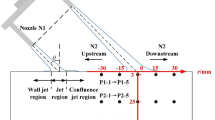Abstract
The influence of cooling models and moving velocity on the temperature variation and cooling rate through the thickness of a metal plate is experimentally investigated. In this investigation, the cooling process is divided into four stages: a starting stage (I), a rapid cooling stage (II), a slow cooling stage (III) and a stopping stage (IV). Based on the curves, cooling rate, temperature difference, the heat transfer coefficient and center temperature curves are discussed. The results indicate that the cooling model and moving velocity influence the heat transfer on the surface, and affects the cooling rate through the thickness by changing the temperature difference. When the flow rates of nozzles 1, 2 and 3 are set to be V1, V2 and V3 respectively, the highest heat transfer is observed when V1 > V2 > V3. Under this cooling model, the maximum temperature difference occurs at the time of transition from the rapid cooling stage (II) to the slow cooling stage (III). In the slow cooling stage (III), increased moving velocity improves the synchronization of the heat transfer and decreases the maximum heat flux. As well, the speed of motion affects the internal heat conduction and cooling rate by affecting surface heat transfer.









Similar content being viewed by others
Abbreviations
- a :
-
Thermal diffusivity (m2/s)
- C :
-
Specific heat capacity (J/kg*K)
- q :
-
Heat flux (MW/m2)
- q max :
-
Maximum heat flux (MW/m2)
- T :
-
Temperature (K)
- r m :
-
Distance from impact line
- r w :
-
Position of the wetting front the impinging line
- u :
-
Steel moving speed(mm/s)
- Ta :
-
Actual temperature
- Tc :
-
Calculation temperature
- τ :
-
The time (s)
- H :
-
Thickness (mm)
- Uo :
-
Initial jet velocity
- q s :
-
Surface heat flux(MW/m2)
- V :
-
Flow rate(L/min)
- w :
-
Length of motion devise (mm)
References
Rossini, Dassisti, Benyounis et al (2012) Methods of measuring residual stresses in components. Mater Des 35:572–588
Sun YK, Di W (2009) Effect of ultra-fast cooling on microstructure of large section bars of bearing steel. J Iron Steel Res Int 16:61–80
Cox SD, Hardy SJ, Parker DJ (2001) Influence of runout table operation setup on hot strip quality, subject to initial strip condition: heat transfer issues. Ironmak Steelmak 28:363–372
Chester NL, Wells MA, Prodanovic V (2012) Effect of inclination angle and flow rate on the heat transfer during bottom jet cooling of a steel plate. J Heat Transf 134:122–201
Wang B, Lin D, Xie Q et al (2016) Heat transfer characteristics during jet impingement on a high-temperature plate surface. Appl Therm Eng 100:902–910
Gradeck M, Kouachi A, Dani A et al (2006) Experimental and numerical study of the hydraulic jump of an impinging jet on a moving surface. Exp Thermal Fluid Sci 30:193–201
Mozumder AK, Woodfield PL, Islam MA et al (2007) Maximum heat flux propagation velocity during quenching by water jet impingement. Int J Heat Mass Transf 50:1559–1568
Fujimoto H, Shiramasa Y, Morisawa K et al (2015) Heat transfer characteristics of a pipe-laminar jet impinging on a moving hot solid. ISIJ Int 55:1994–2001
Wang H, Yu W, Cai Q (2012) Experimental study of heat transfer coefficient on hot steel plate during water jet impingement cooling. J Mater Process Technol 212:1825–1831
Zeitoun (2012) Heat transfer between a vertical water jet and a horizontal square surface. Experimental Heat Transfer 25:206–221
Wang B, Guo X, Xie Q et al (2016) Heat transfer characteristic research during jet impinging on top/bottom hot steel plate. Int J Heat Mass Transf 101:844–851
Zhang L et al (2010) Inverse identification of interfacial heat transfer coefficient between the casting and metal mold using neural network. Energy Convers Manag 51(10):1898–1904
Wang B, Lin D, Zhang B et al (2018) Local heat transfer characteristics of multi jet impingement on high temperature plate surfaces. ISIJ Int 58:132–139
Zhang J et al (2014) Design of the multi-stage quenching process for 7050 aluminum alloy. Mater Des 56:334–344
Tian-Liang F, Jun H, Xiang-Tao D et al (2017) Experimental study on thickness cooling rate of jet impingement quenching for ultra heavy plate. Journal of Northeastern University 38:1548–1553
Choi YH, Lee YW, Choi K et al (2012) Temperature distribution and thermal stresses in various conditions of moving heating source during line heating process. J Therm Sci 21:82–87
Acknowledgments
This research was jointly supported by the national natural science foundation of china (51404058), the fundamental research funds for the central universities (N150704005), and the open project of the RAL at northeastern university (2016006).
Author information
Authors and Affiliations
Corresponding author
Ethics declarations
Conflict of interest
No potential conflict of interest was reported by the authors.
Additional information
Publisher’s note
Springer Nature remains neutral with regard to jurisdictional claims in published maps and institutional affiliations.
Rights and permissions
About this article
Cite this article
Wang, B., Xia, Y., Liu, Z. et al. A study of heat transfer through the heavy plate thickness under multi-slit jet impingement. Heat Mass Transfer 56, 663–670 (2020). https://doi.org/10.1007/s00231-019-02738-3
Received:
Accepted:
Published:
Issue Date:
DOI: https://doi.org/10.1007/s00231-019-02738-3




